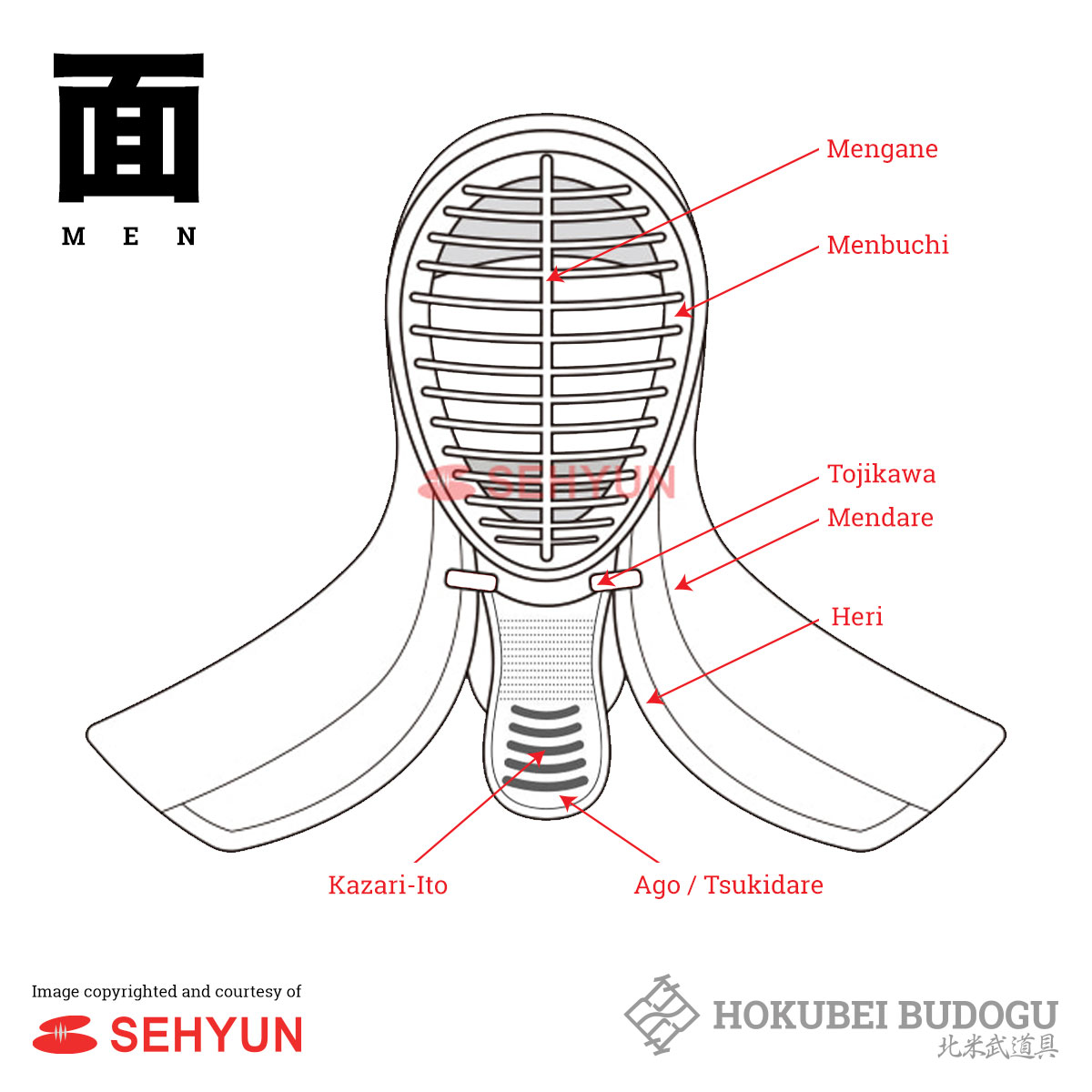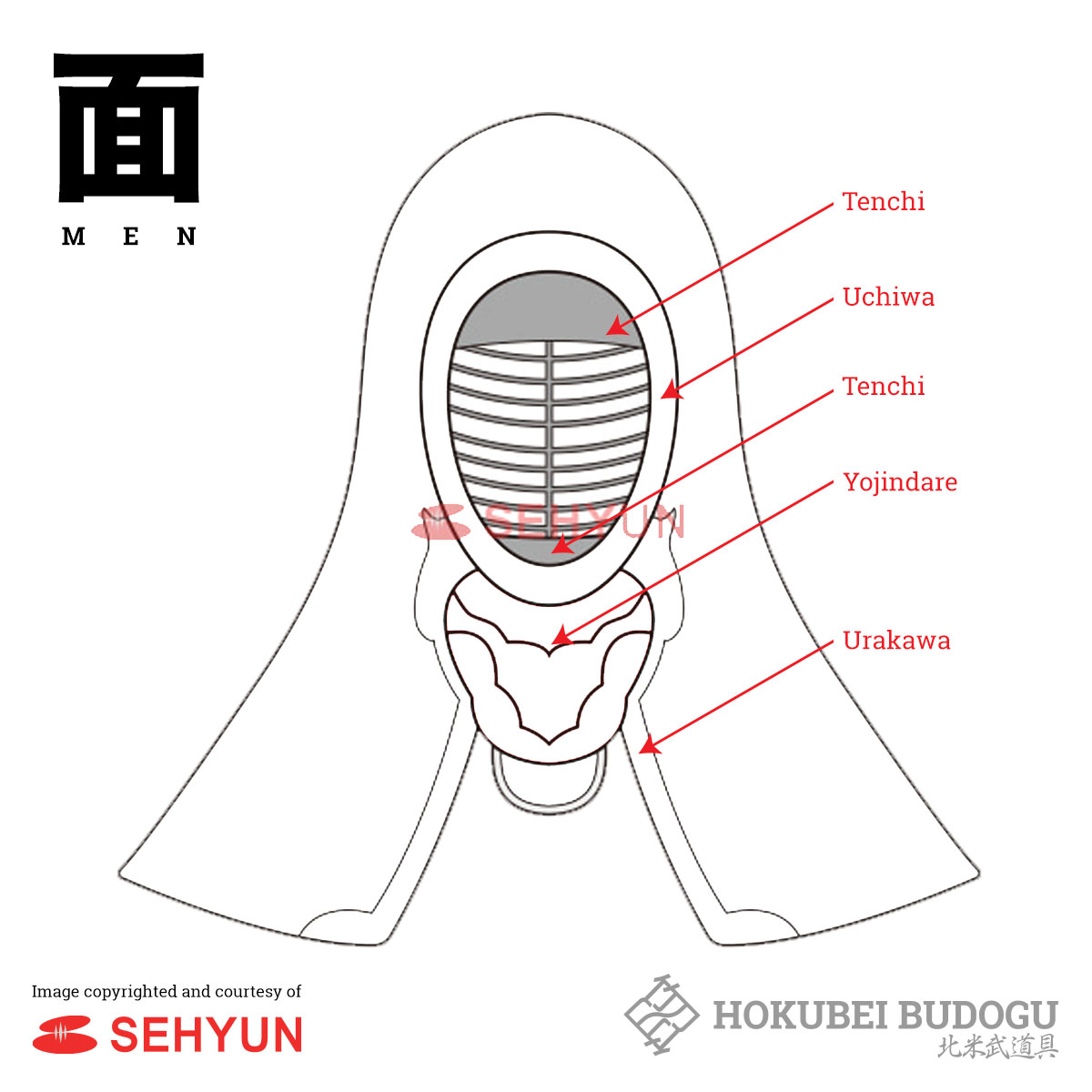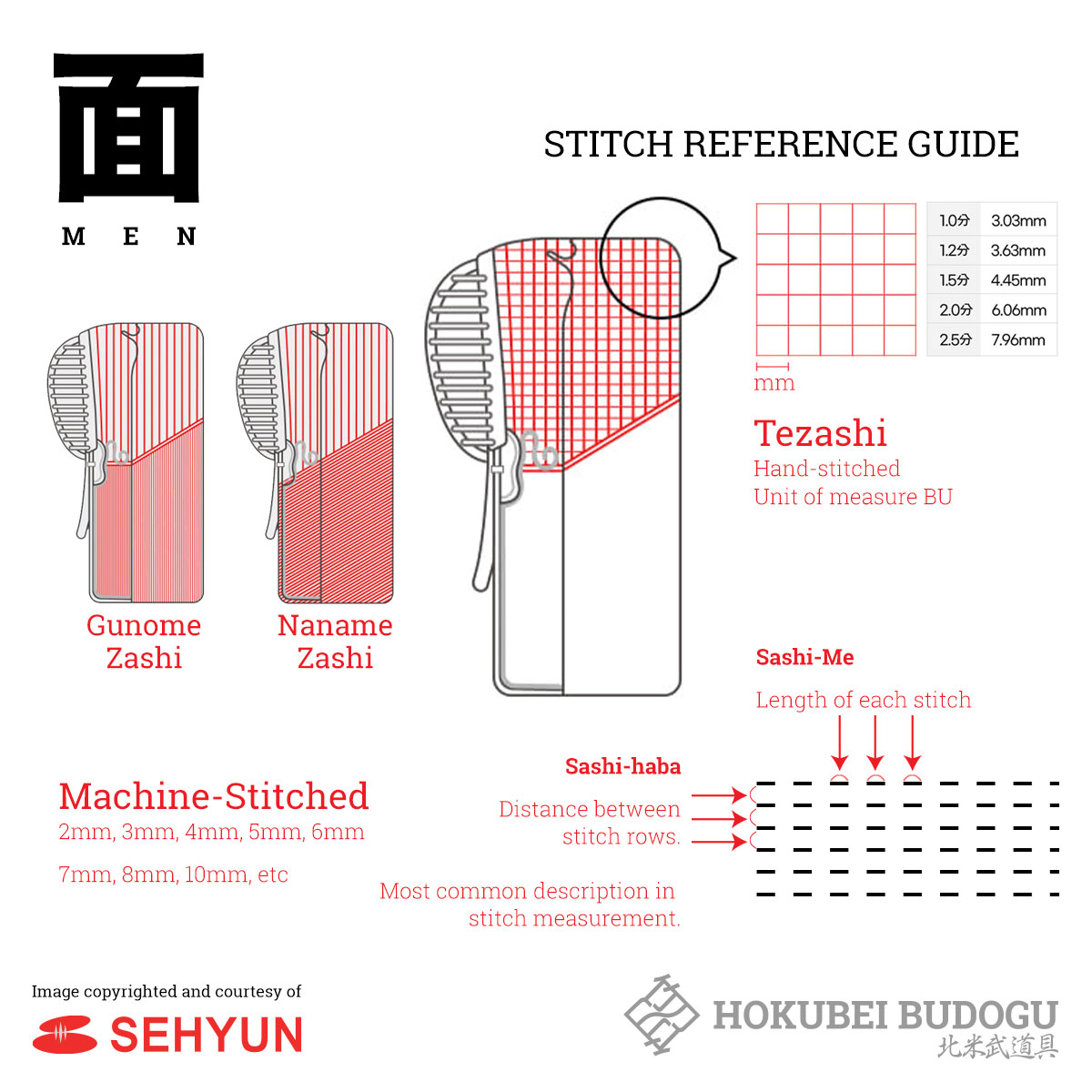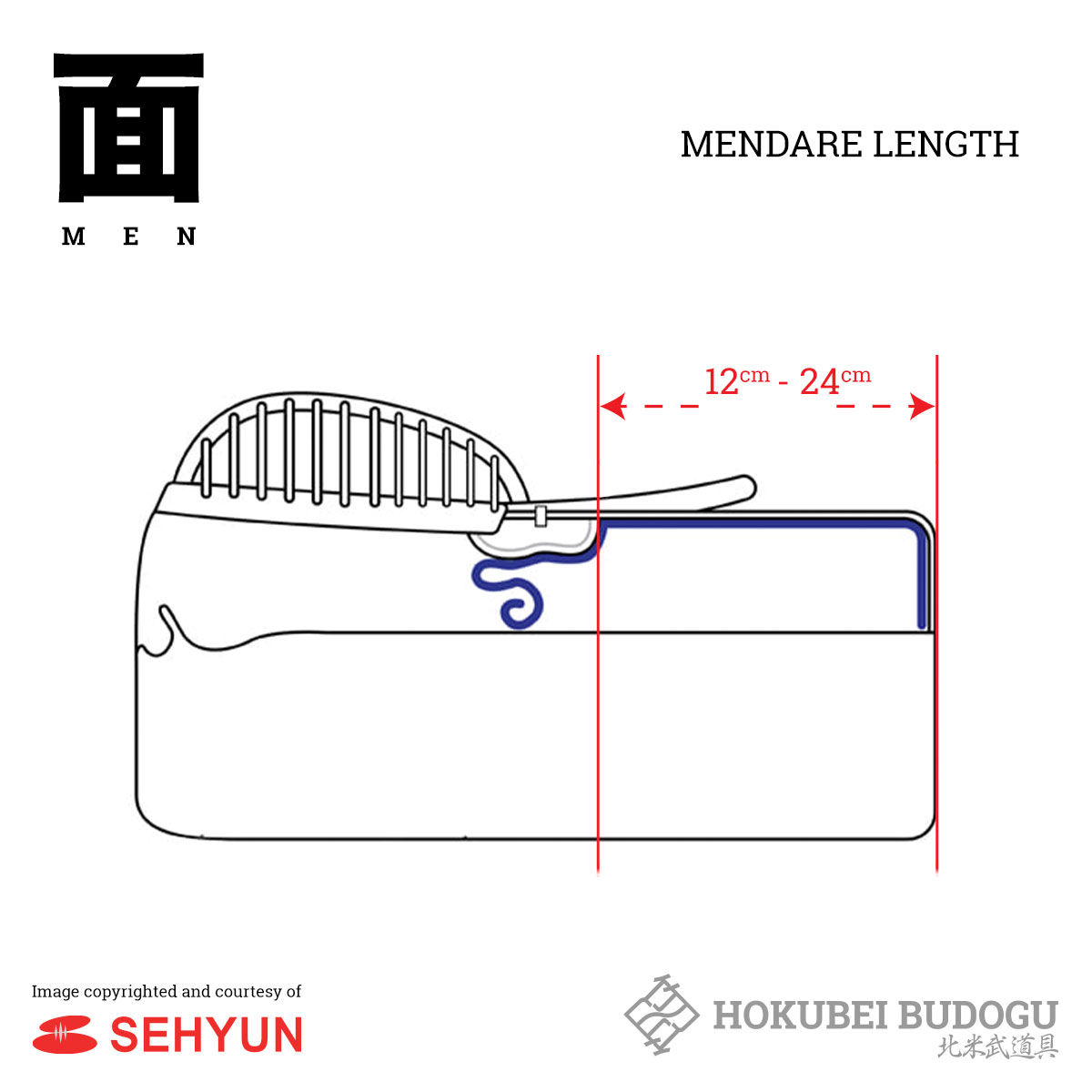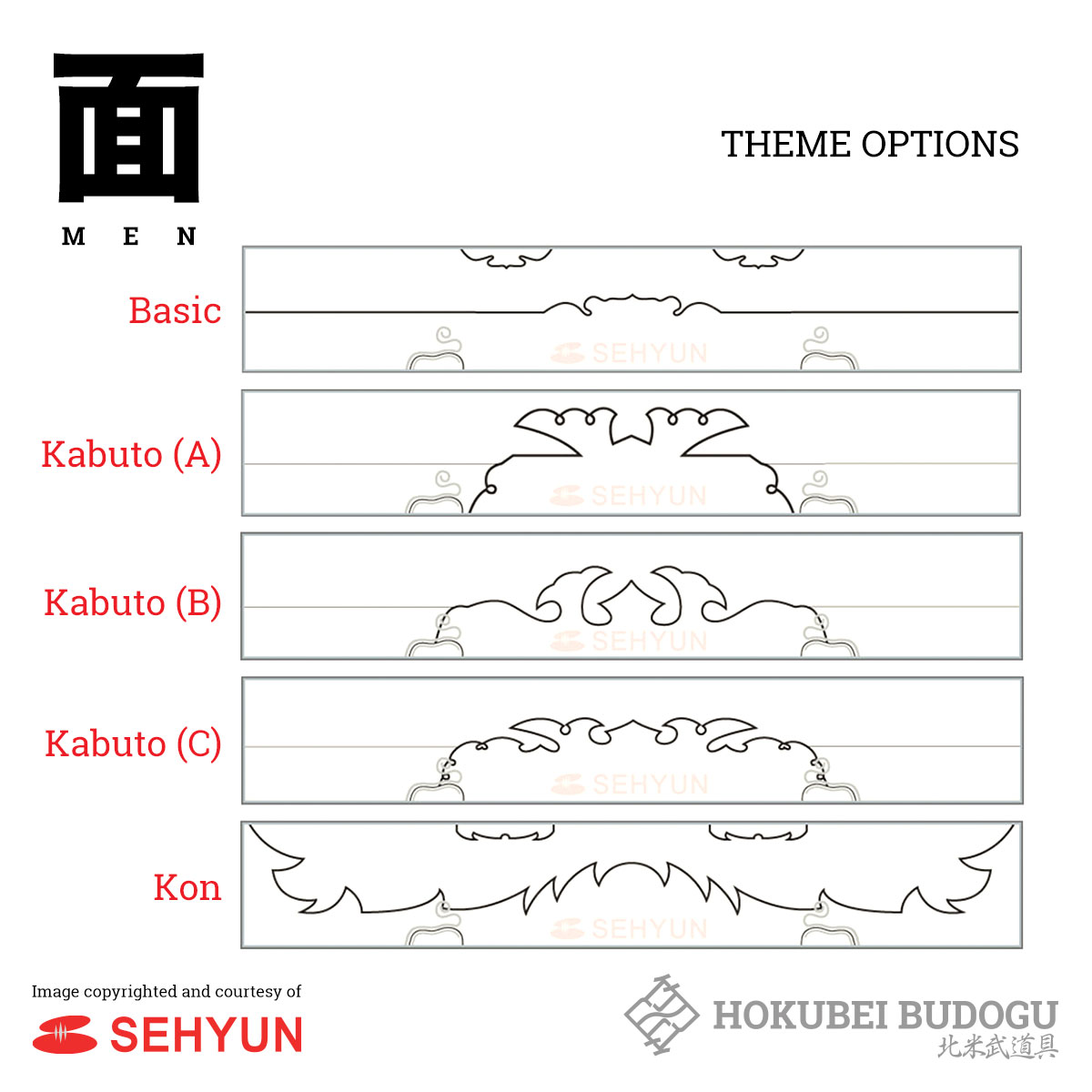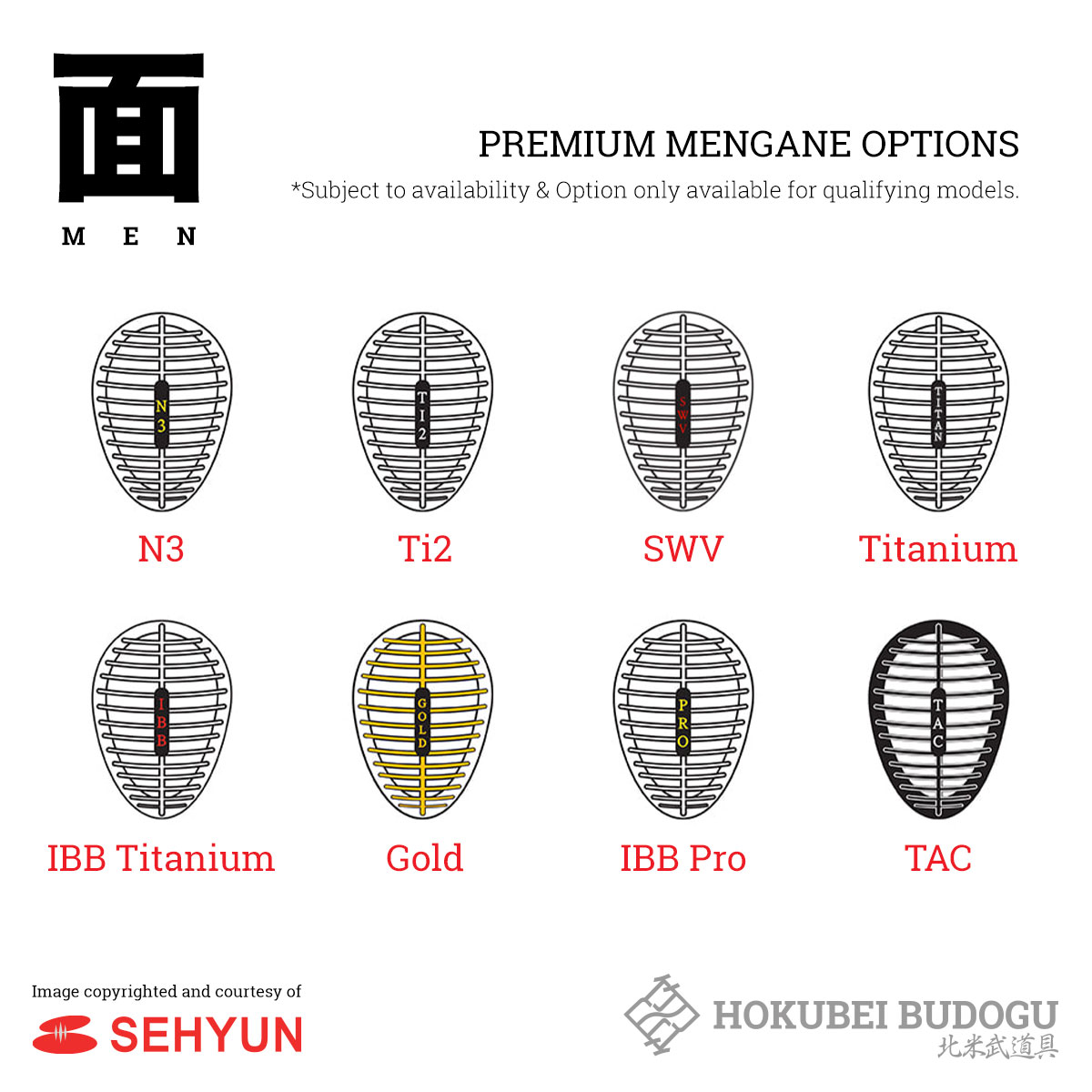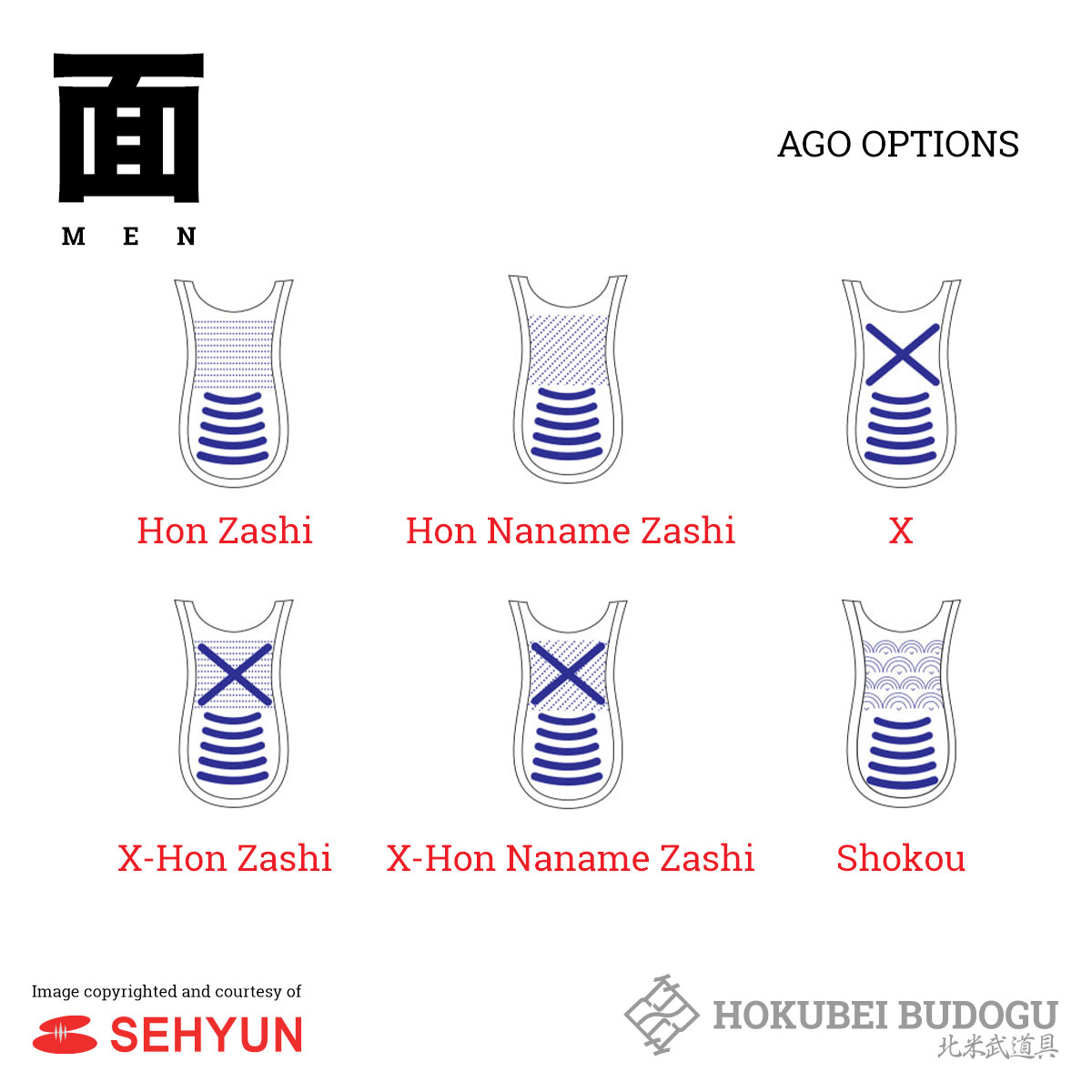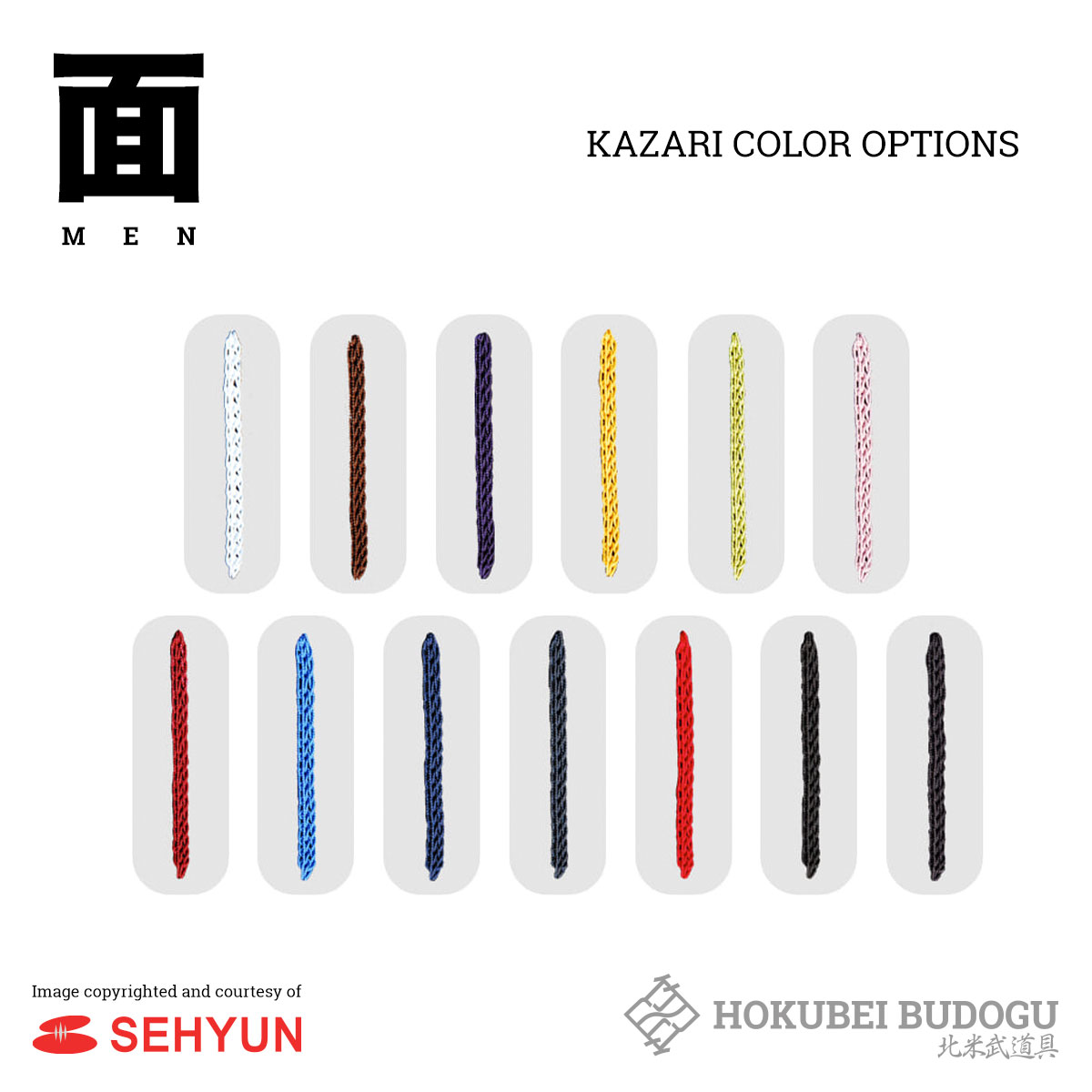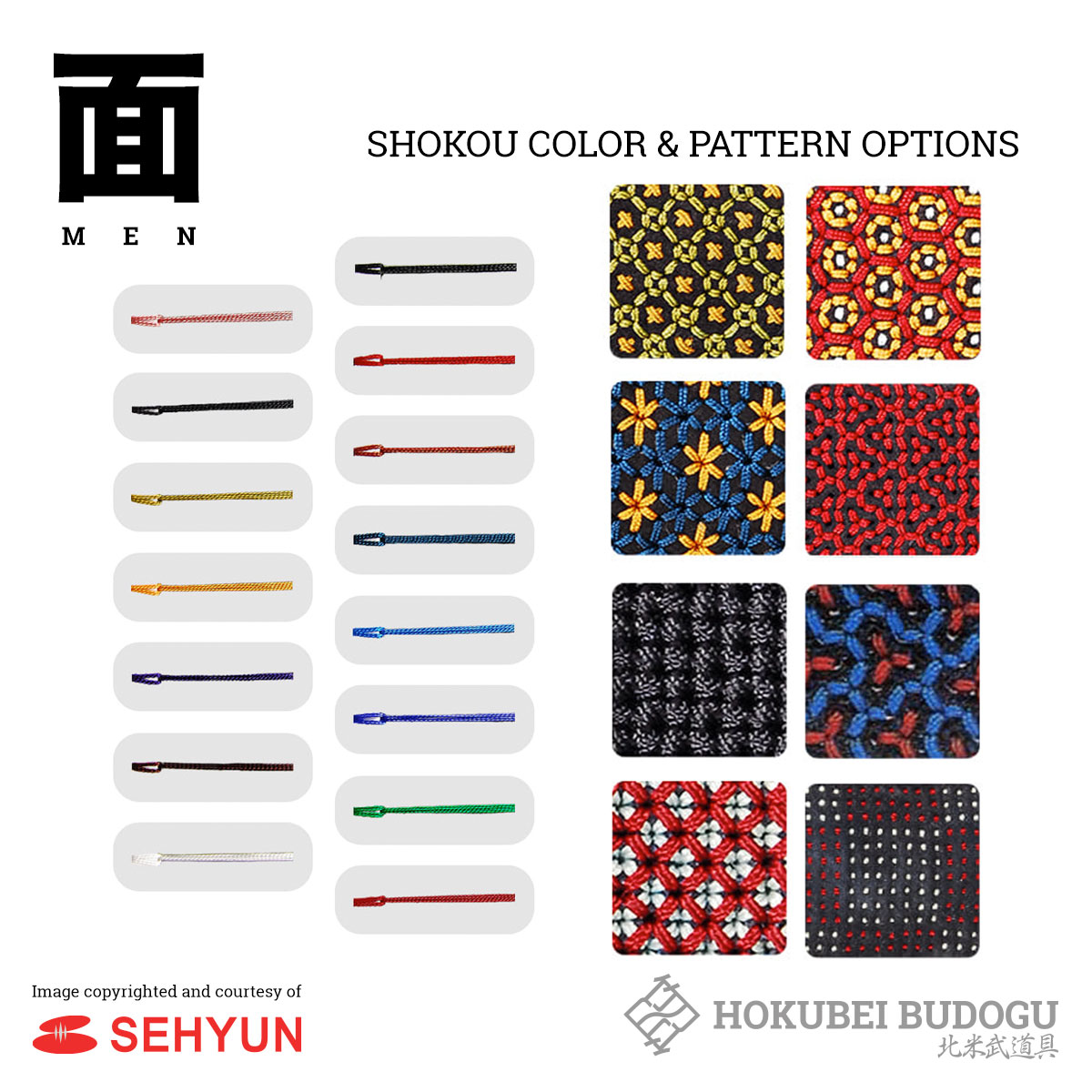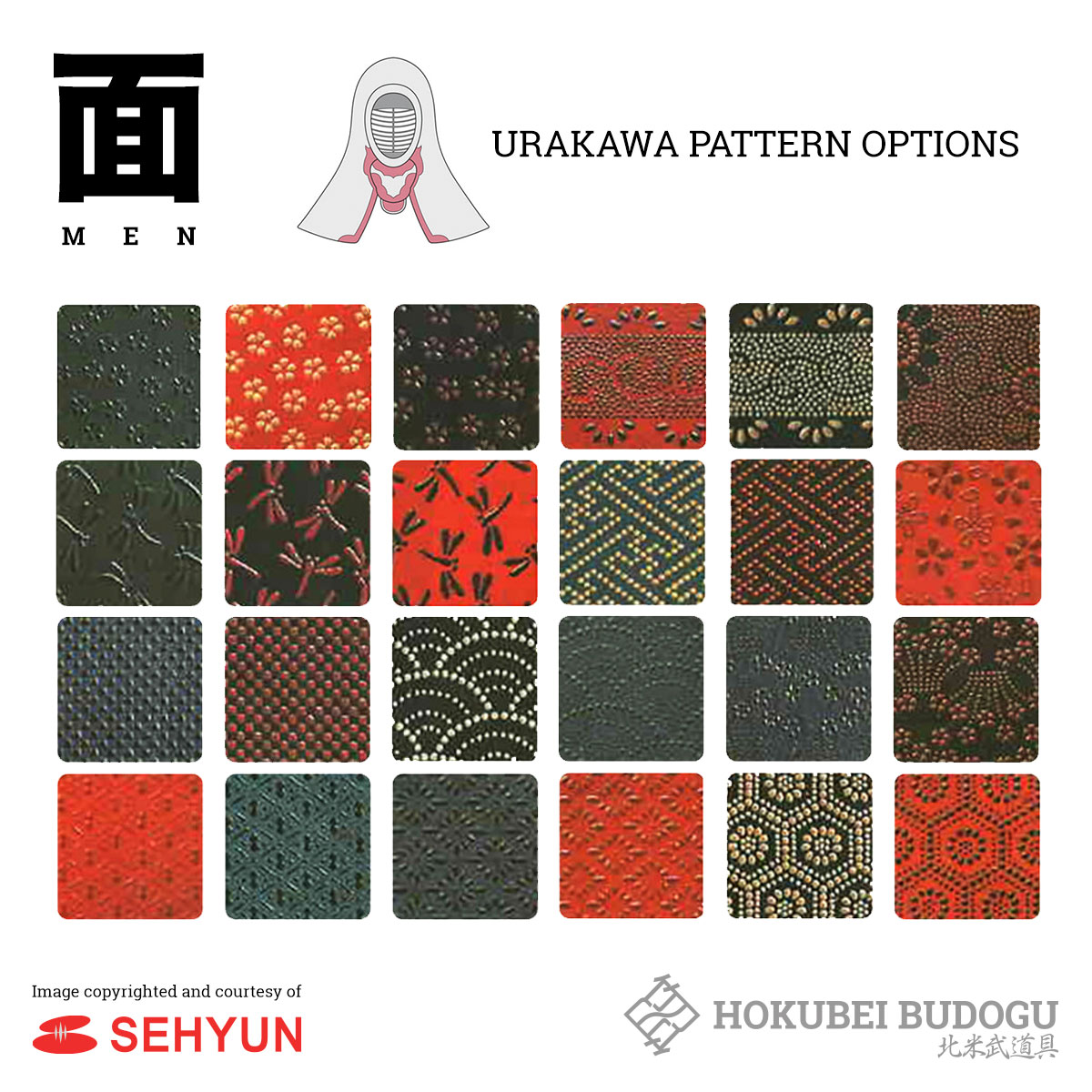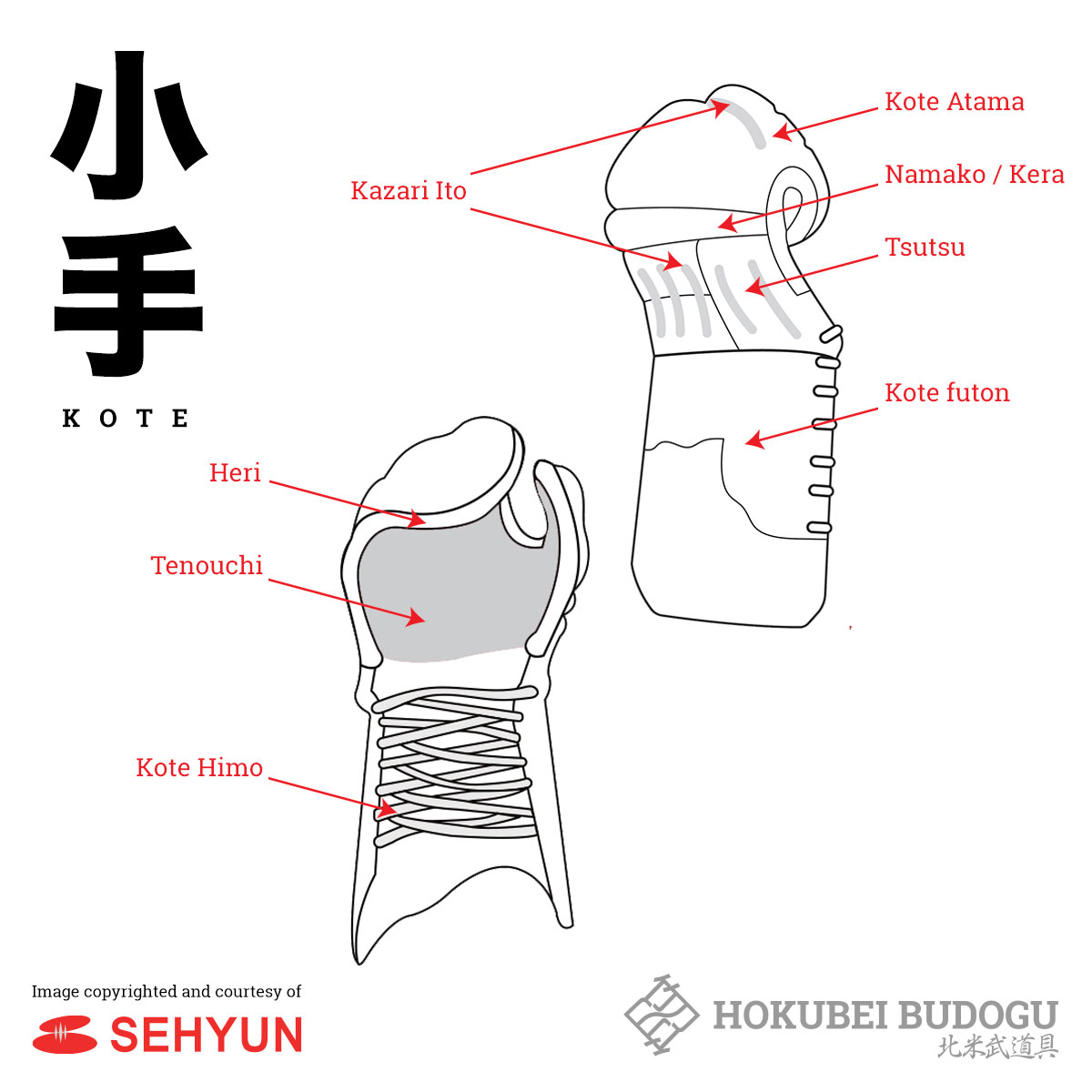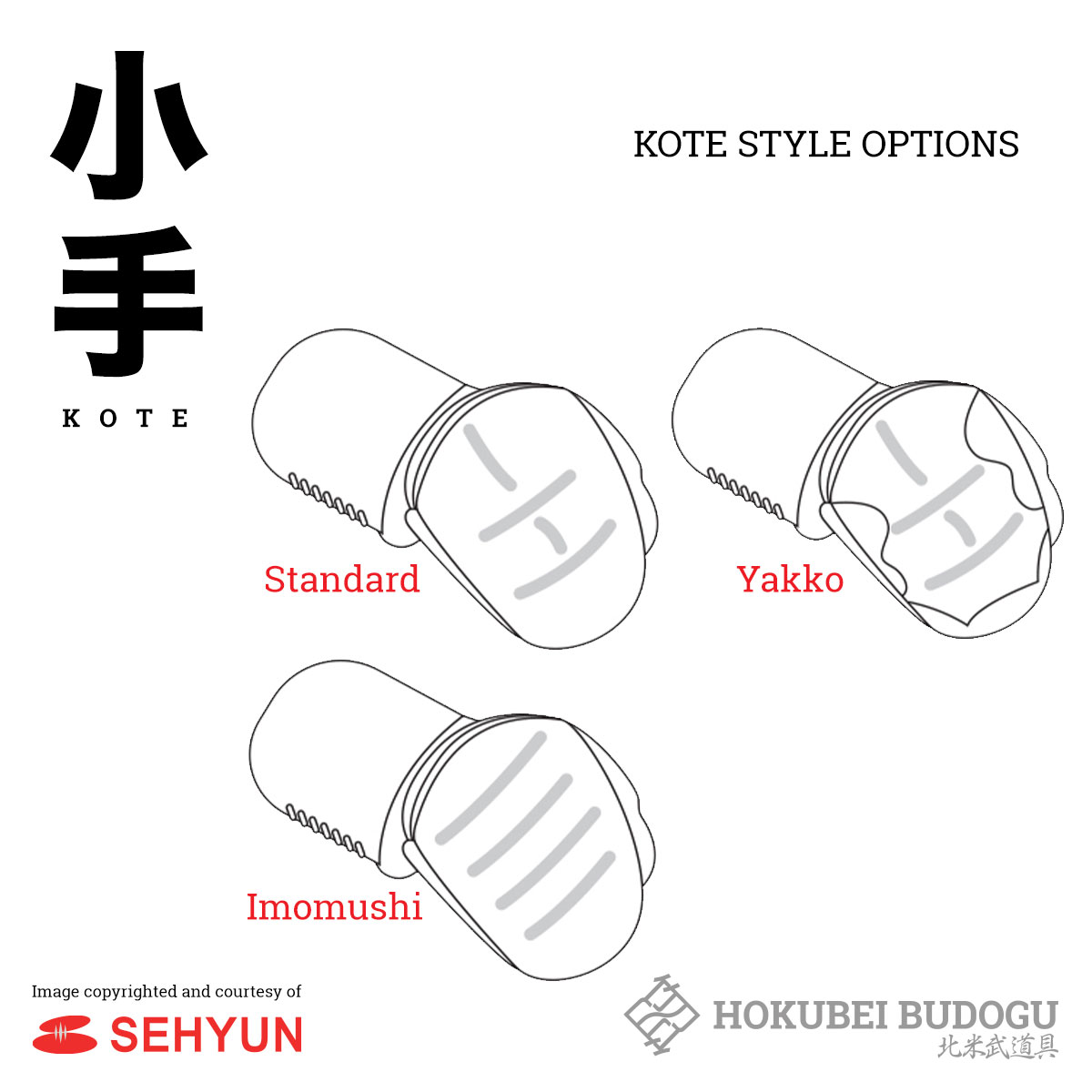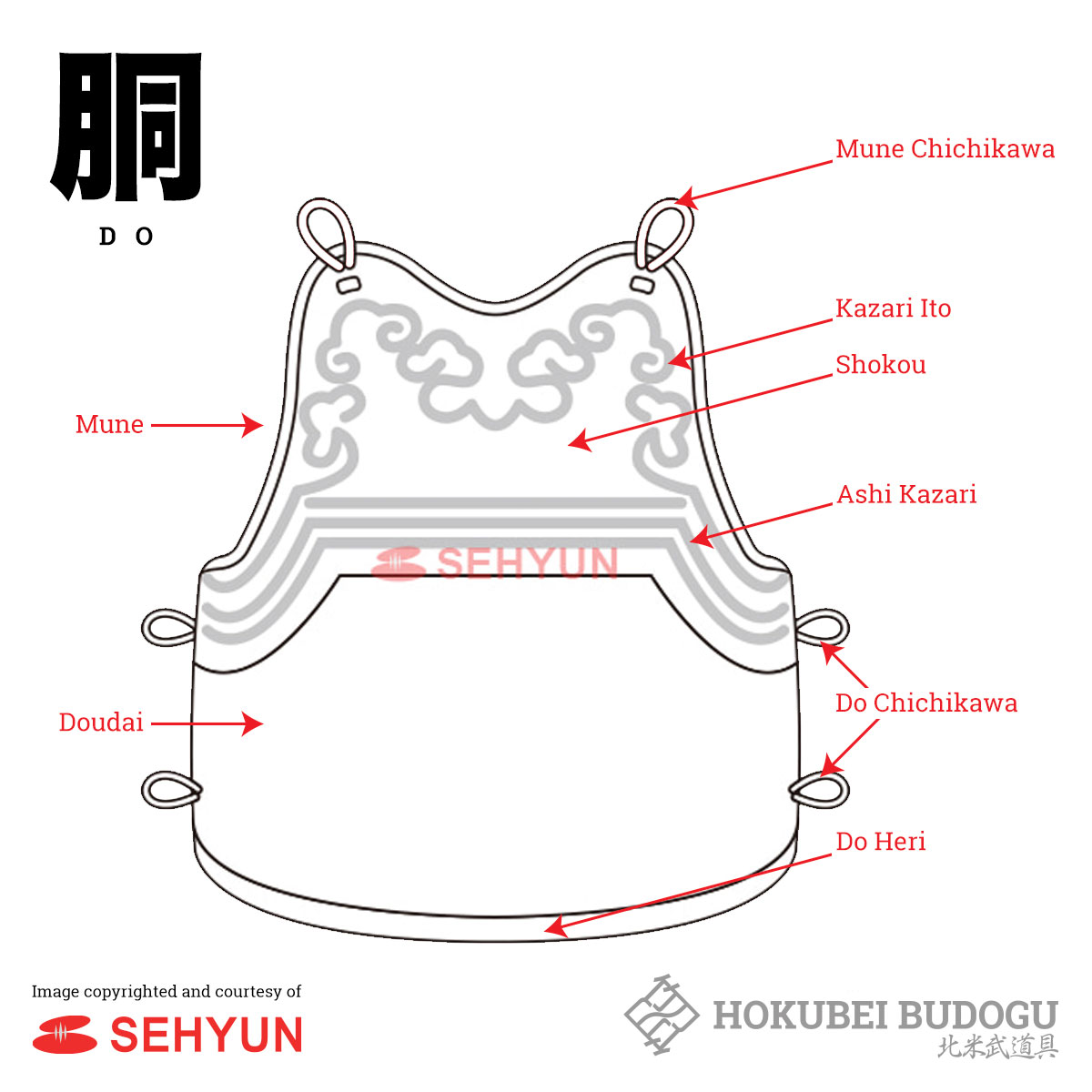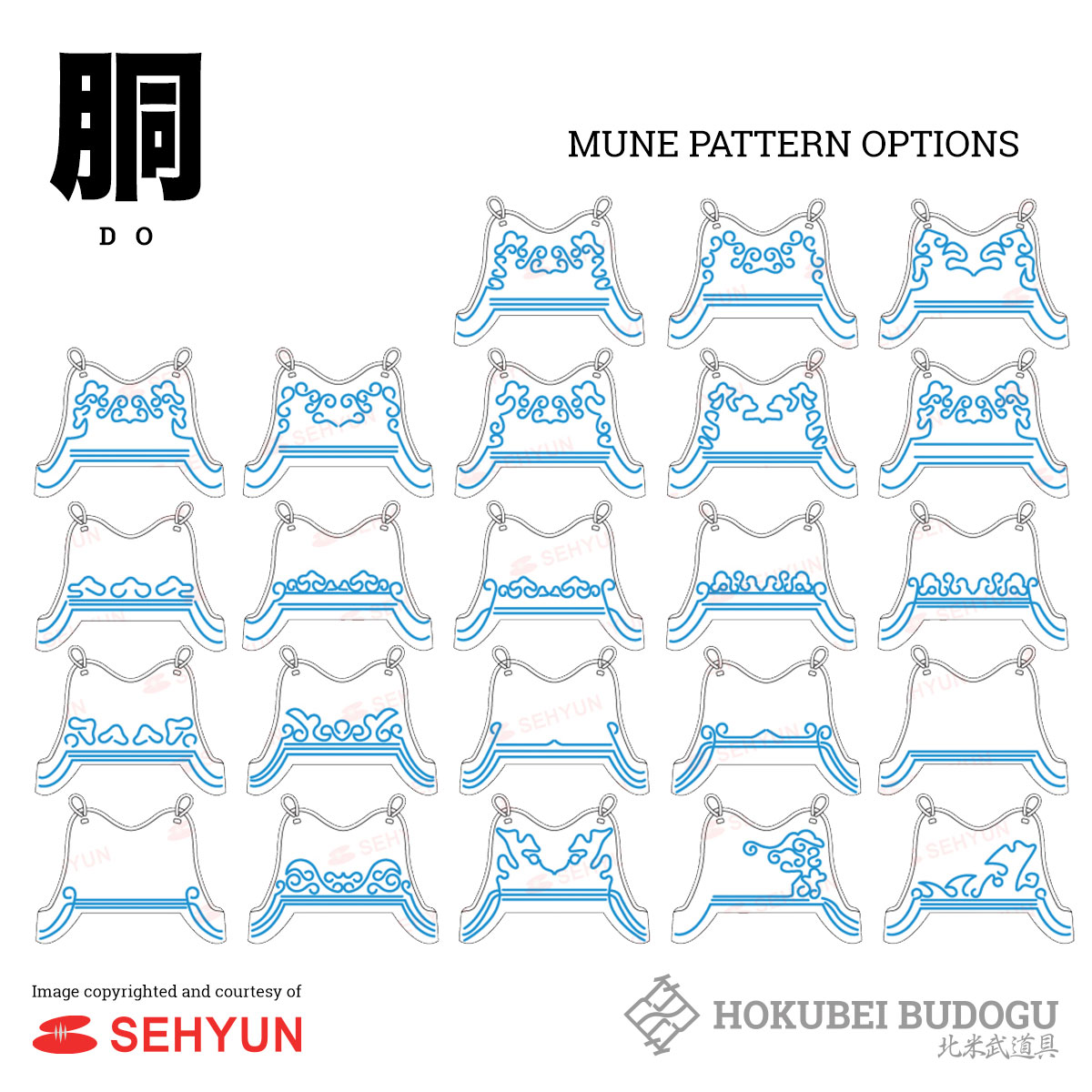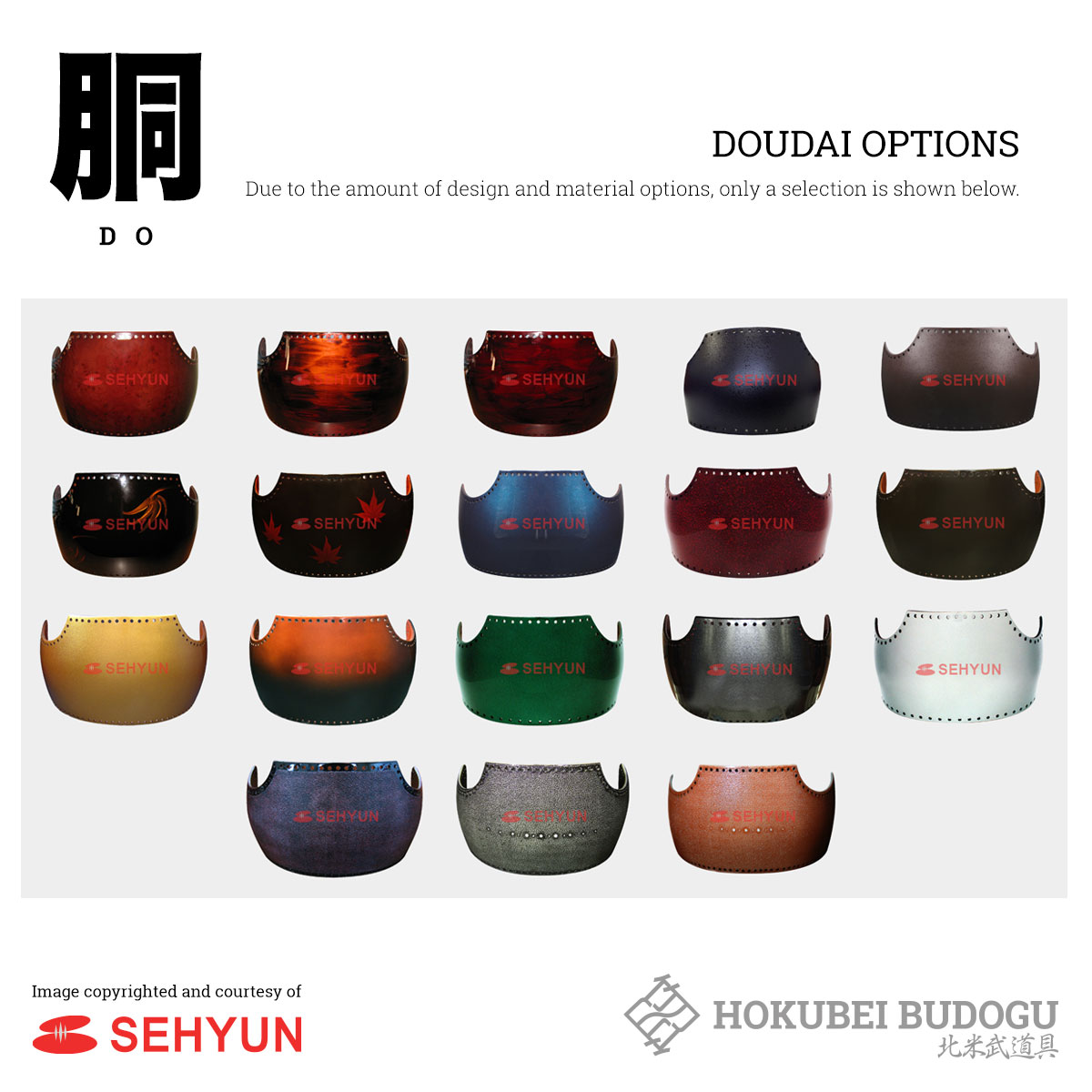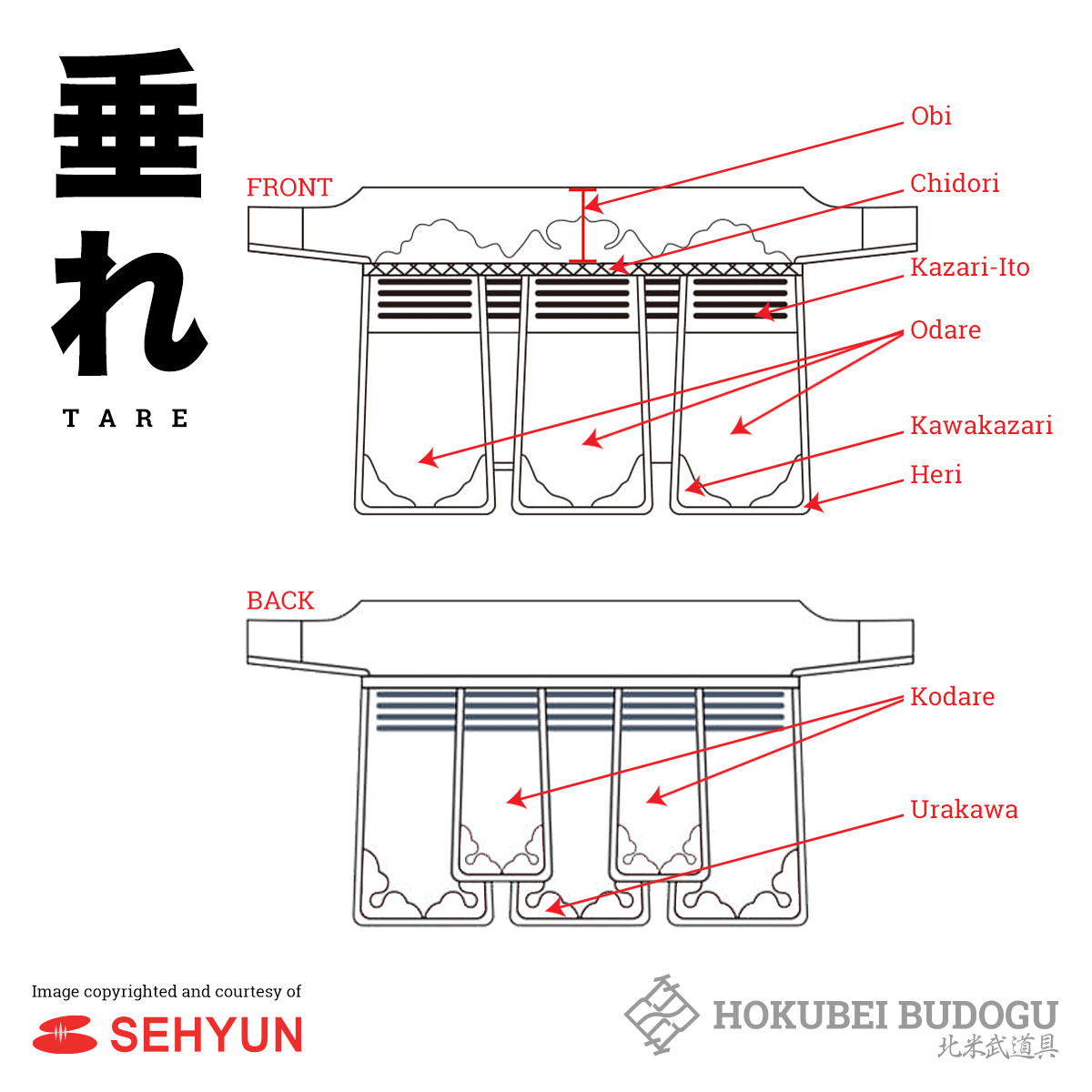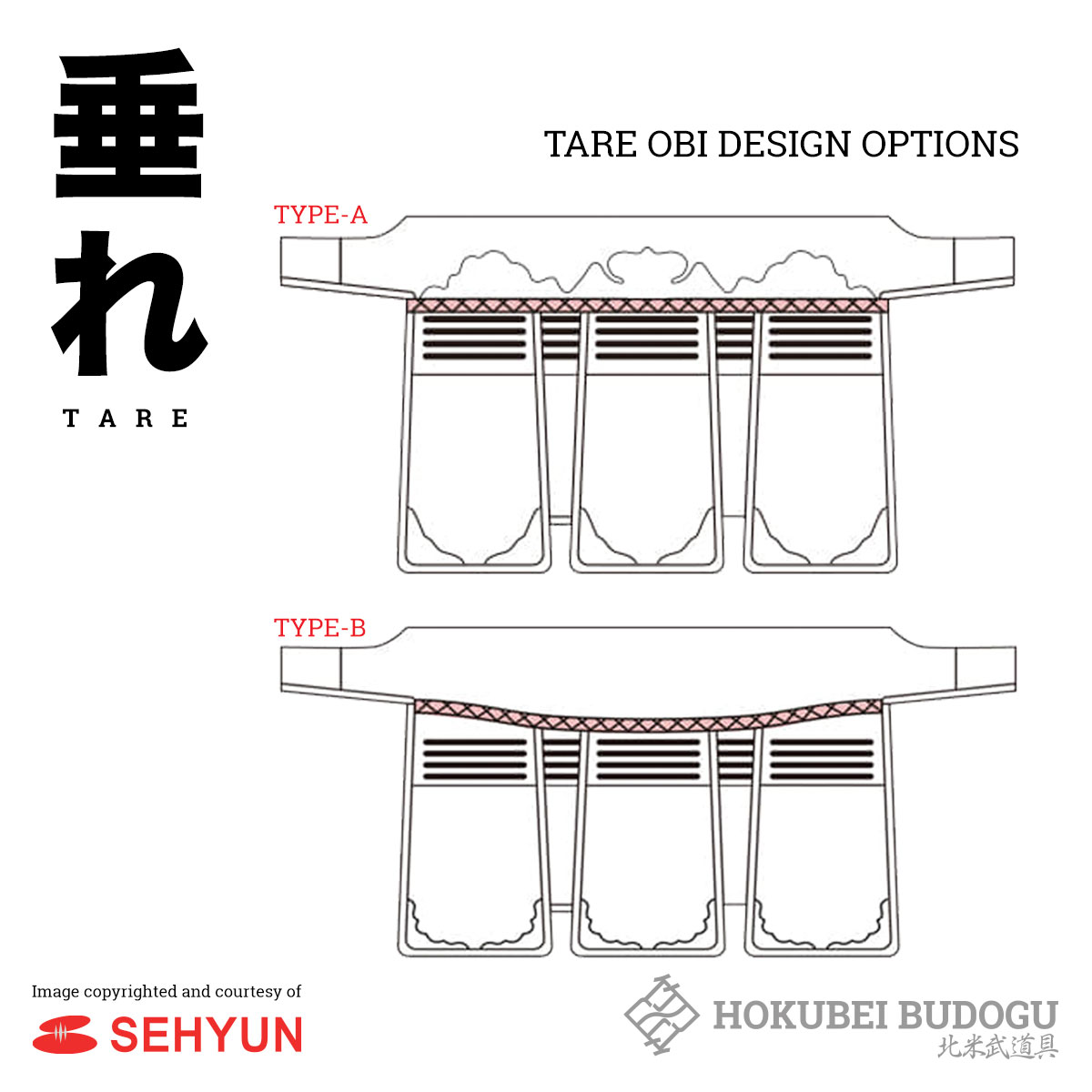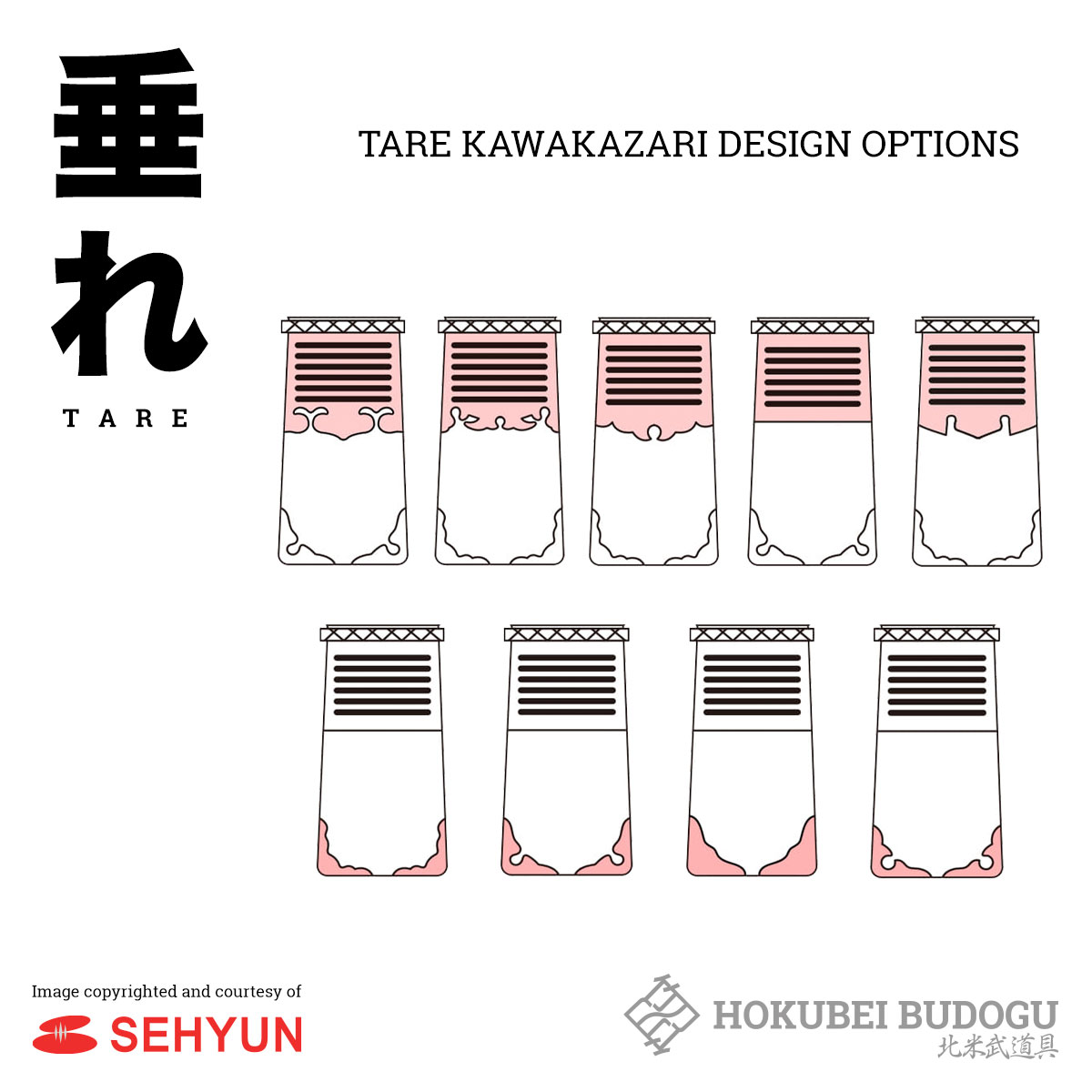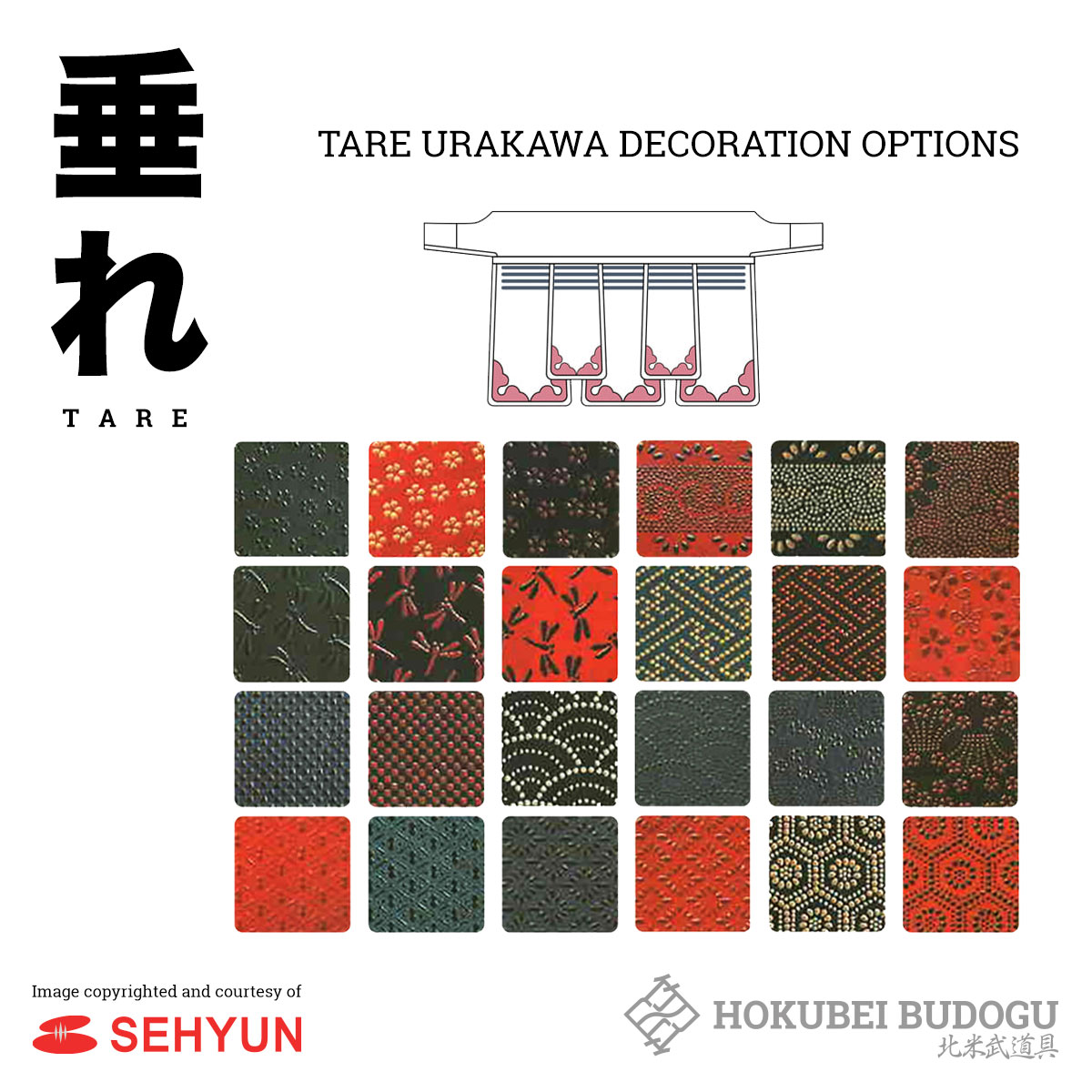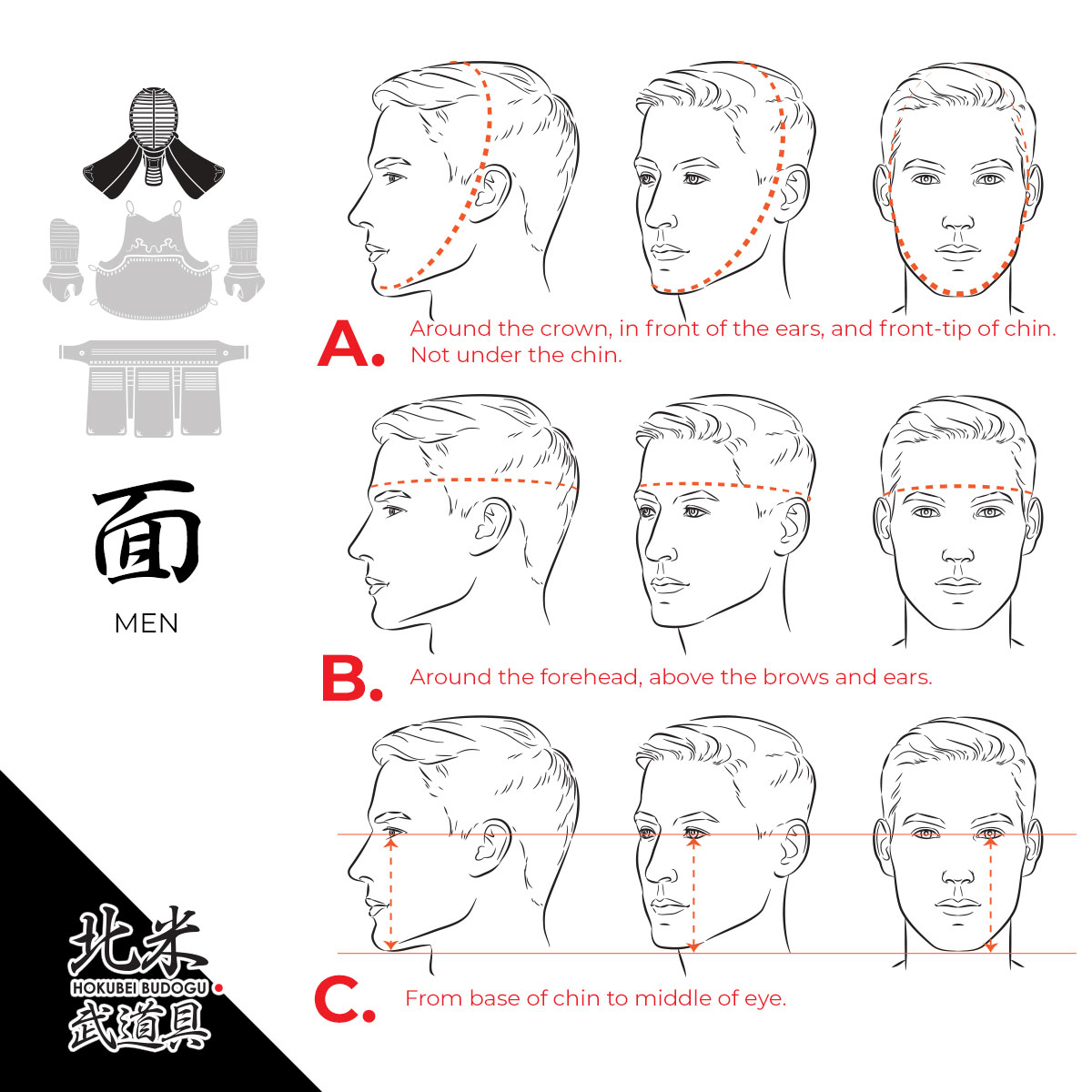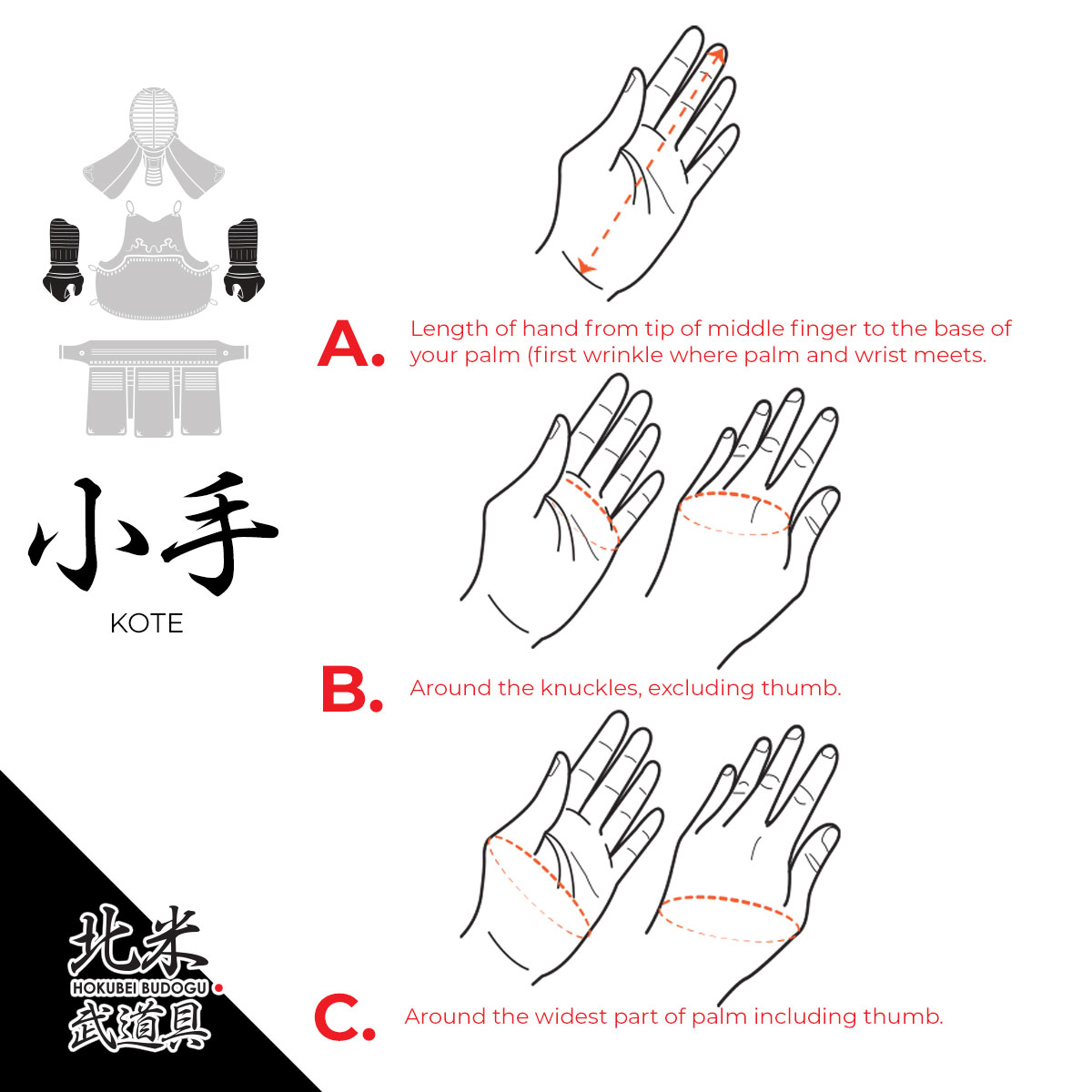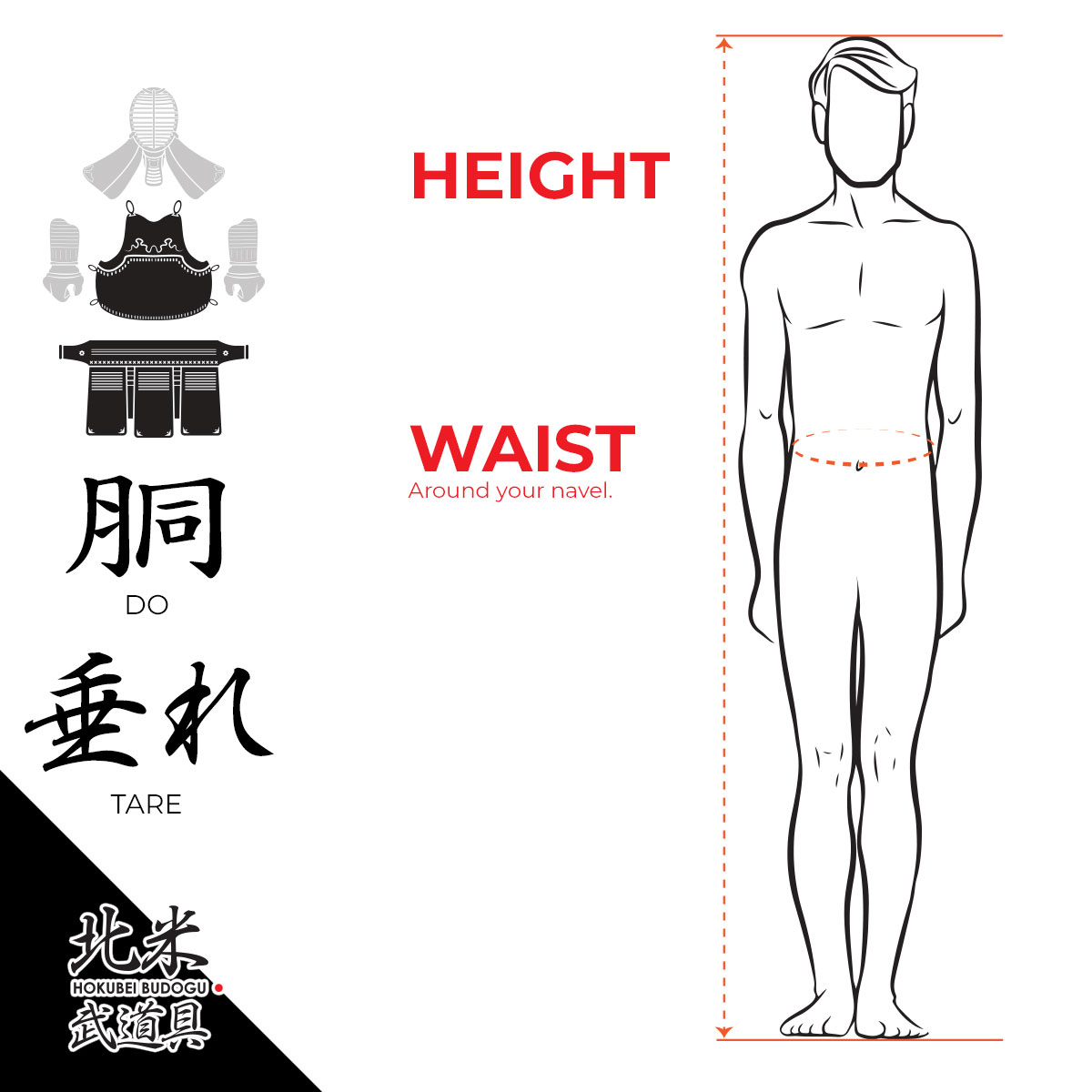Kendo Bogu – There is a lot to know. We hope this guide will help you.
"MEN"
The mask. The helmet. The icon of Kendo. The “Men” is the most well recognized piece of Kendo equipment, even to the non-Kendo crowd. Not only is it a piece of equipment to save your head during the practice of Kendo, but a piece of art.
The “Men” is composed of several different parts, and the illustration, courtesy of Sehyun Kendo, is labeled for easy understanding.
Mengane – The iron grid that protects your face, is made of strong and light metals – most commonly Titatium or Duralumin.
Menbuchi – The leather mounting which holds the megane to the men futon.
Ago or Tsukidare – The throat protector and target where the opponent can do the stab called “tsuki”
Tojikawa – A piece of plastic or leather strip that holds the ago/tsukidare to the men futon.
Mendare – The extended part of the men futon which provides shoulder protection. The length of the mendare can be customized in certain sets. Some prefer shorter lengths to allow for easier shoulder movement.
Kazari-ito – Stitchings on the ago, and also seen on the mendare, which are decorative features. Does not affect the performance of the “men”.
Tenchi – The parts that support, and fit on the user’s forehead and chin.
Uchiwa – A cushion that fits around the user’s face for protection and comfort. High-end custom bogu even makes the Uchiwa mold around the user’s face for that perfect fit.
Yojindare – The part that rests behind the ag0/tsukidare for added protection and support.
Urakawa – Usually strips of clarino, or leather with patters to decorate the inside of the “men” or the rear side of the “tare”. For decoration purposes, and does not affect the performance of the equipment.
The stitch patterns and units of measurement is standard for all parts of a Kendo bogu.
The bogu is categorized into two main categories. The machine-stitched sets and hand-stitched sets (tezashi).
Tezashi, or hand-stitched, sets refer to the stitch width called the “bu”, where each bu is equivalent to 3.03mm. The patterns of this stitch method square in appearance, and are the pinnacle of bogu craftmanship. Available options are 1.0bu, 1.2bu, 1.5bu, 2.0bu and 2.5bu. The lower the number of bu, the tighter the stitching on the futon, and this means it is stiffer than the higher number of bu, however, the durability and shaping ability are significantly higher.
The higher bu numbers are more comfortable and softer, and because the futon is less compact, it can offer more cushion to impact but will look more “floppy” in appearance.
When it comes to machine-stitching, you will come across 2mm, 3mm, 4mm, 5mm, 6mm, 7mm, 8mm and 10mm sets. As described above, the stitch number reflects the same characteristics. The stitch number refers to the width of each stitch row, and this is called the Sashi-haba. The actual stitch length, or the pitch, is called the sashi-me, and this is used less to describe the bogu type.
Gunome zashi, is a general description of the traditional straight-line stitching on the futon, and Naname zashi is a diagonal stitching pattern, and widely used on the mendare for design purposes.
The mendare is the flap or wing that protects your shoulders. Most standard and common length is 20cm, however the recent trend was shorter mendare for mobility enhancement for competitions. Some of the higher-end bogu sets have the option to customize the length to your preference. Please do remember, that this is a protective piece, so it should be considered when opting for shorter mendare lengths.
Kendo bogu sets usually have a design theme. It is prominently seen on the men, kote futon, and on the obi of the tare. The designs shown here are based on Sehyun Kendo products.
Again, there is no performance value here, and these are decorative features. Some high-end bogu sets have the option of reinforcing the front part of the design with leather for enhanced durability, while others are just an extra layer of orizashi.
Standard mengane is duralumin or titanium IBB. The metal substrates can differ in weight, balance, and of course price. The options shown are for higher-end “men”, and this is all personal preference as well.
The ago, or tsukidare, has two parts to customize. The Kazari-ito, which is the dark bold blue pattern shown in the illustration, and you can choose different thread colors. The Shokou can have different patterns and colors, which is shown in lighter blue in the illustration. Again, customizing options are available with high-end bogu sets, and these are decorative features and do not add to the function of the piece.
These are the available thread colors for the Kazari-Ito parts of the bogu, to give it a personal touch. Customizable on high-end bogus, and usually standard black/blue on stock bogu sets.
It is a good idea to keep the Kazari colors uniform on your men, mune, kote and tare.
Shokou design is the finer touch of personality on your mune and ago/tsukidare. Different colors and design patterns are available for your custom bogu.
Another decorative option is the urakawa on your men and tare. These are not visible when worn, but can help make your bogu look different, or identifiable. These decorative features are personal preference and does not impact the performance of your bogu.
"KOTE"
The “Kote” or glove, or gauntlet, is very important in terms of protection, and the ability to help the user to comfortably hold the shinai and perform tenouchi.
The kote will have the most wear and tear on the palm due to friction and sweat when holding a shinai, and needs to be cared for carefully to increase its life span.
The Kote Atama, or the fist, is usually filled with deer hair, or synthetic cotton, and when getting a pair of kote, this needs to offer good protection.
The Namako, and tsutsu are where the atama and kote futon join, and are the flexible part of a kote. Poorly made kote will not be flexible at this part and will interfere with your shinai control and movement. For movement enhancement, these areas are not padded like the rest of the kote.
The kote futon, is where the most strikes will me made during kote waza, and should serve its most important purpose: protection. To increase protection, there are wrist protectors available on the market to supplement the padding.
Like all other kendo equipment, Kote also has a variety of designs. It is difficult to say which is better than which, and is based on personal preference.
In the illustration, the Yakko style has added reinforcement around the common wear and tear parts on the atama (fist) of the kote. Usually an extra layer of leather or orizashi, which can have some patterns to give it a bit of decorative enhancement. The primary function is to increase the life span of the kote’s atama.
Th imomushi has unique stitching on the atama to help improve the curl or grip of the shinai. Some people love it, and others do not like the clumsy look of it. Again, personal preference.
The most important feature to consider when getting a kote is protection, and comfort when performing tenouchi.
"DO & MUNE"
The mune is usually made of deer leather, cow leather, synthetic leather, or orizashi, and is the piece that sits on top of the hard dome part of the construct (dou-dai) which protects your chest. The mune chichikawa is the loop in which you tie your do himo. These can break over time and are repairable.
The mune, like the ago or tsukidare of the men, is also composed of kazari-ito and shokou for decoration, and options are available to customize it for high-end bogu sets,
The dou-dai, or dome-looking part is the torso protector, where the do-waza is received. The materials can be plastic, carbon fiber, and the premium of all dou-dai… the kiji-dou, which is made of bamboo slats.
The standard dou-dai is a high gloss black plastic, but higher grade do can have added color, gloss or matt finishes, or even leather. Rayskin (same-do) is a premium option on the dou-dai.
Do usually come in 3 sizes. Stadard 55, large 60 or an extra-large 64. Custom options are available to make even larger do. The price however escalates because the mune has to also be separately constructed to fit the enlarged do.
The blue lines are the kazari-ito and available patterns on the mune. Different color threads can be chosen for high-end bogu sets that allow customization. The center of the mune is the shokou, and can have different patterns and colors to enhance the look of the mune.
Dou-dai options are categorized into material, color, finish, and material. There are hundreds of available options, and the price can range from under $100 to over $4,000.
The most basic ones are plastic, with high-gloss black paint, and some of the most expensive ones are bamboo (kiji-do) with stingray skin coverings.
Weight is also a consideration when picking a dou-dai, and recently carbon-fiber do has been popular.
"TARE"
In our opinion, the piece of bogu, that nobody cares for, is the “tare” – thigh and groin protector.
These are however an essential part of a kendo bogu to protect your legs during keiko, The larger three flaps in the front are called the odare, where the center flap is used to place your zekken (name tag).
Th kodare are the two smaller flaps behind it for added protection.
The odare and kodare are separated to allow free movement of the user’s legs and to provide protection at the same time.
The obi is essentially a thick “belt” which helps to sit on the user’s abdomen snuggly so the tare does not come off or rotate during keiko. A himo is attached at the end of the obi, and is used to wrap around the waist to be tied securely under the center odare.
Besides the kazari-ito, kawakazari and urakawa decoration options, Sehyun Kendo provides two design options. The available option is the Type B, which has a diagonal finish on the left and right odare where it meets the obi. This diagonal line makes the tare fit better around the hips, and adds a good aesthtic value when worn.
